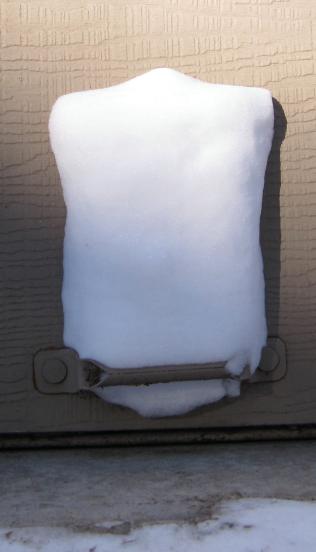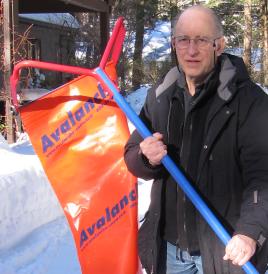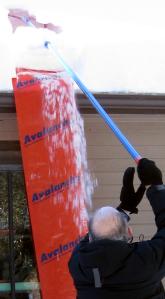
The snow started around noon on Friday, February 8, and continued overnight. It’s hard to tell just how much snow we got here, because it drifted around a lot in the wind. The picture to the left shows a yardstick stuck in the snow outside our mudroom door (a yard = three feet = 36 inches is 91.4 cm). The picture was taken Saturday morning, and it shows a snow depth of 30 inches (76 cm). We had plenty of warning of the coming storm, and since we usually are confined to our house and lose electricity in events like this, we had plenty of food and flashlight batteries on hand. We didn't allow the thermostats to set back to a lower temperature overnight, and we reduced our refrigerator and freezer temperatures, to better preserve food in the event of an outage. We didn’t put aside any water, as even in the worst of storms, we’ve never lost our town water pressure. Besides, we couldn't go thirsty, because we had half a case of Pellegrino left over from Elissa’s Italian-themed baby shower (Qu’ils mangent de la brioche !). The Commonwealth of Massachusetts imposed a driving ban from Friday noon until Saturday at 4:00 PM, which was widely credited with reducing injuries, and making it possible for plow drivers to keep the roads clear. But although we had no major problems here in Wayland, and we didn’t even lose electricity, there was quite a bit of damage along the coast. A "nor’easter" (a coastal storm in which the wind comes from the northeast) blows a storm surge into Cape Cod Bay, so there was quite a bit of flooding there at high tide (in Sandwich, Massachusetts, the high tides were at 9:43 PM Friday, and 10:00 AM Saturday). We were also near a “new moon”, so the tide was already a bit higher than average, and waves washed up over the roads. It's unusual for us to not lose electricity in a storm with wet, heavy snow, and high winds. We may have been spared because hurricane Sandy, at the end of October, took down many of the weak trees and branches. Sitting out a storm is quite comfortable if you have heat and electricity. Here's what I saw on Saturday morning when I opened my front door (click to enlarge, return with "Back"): 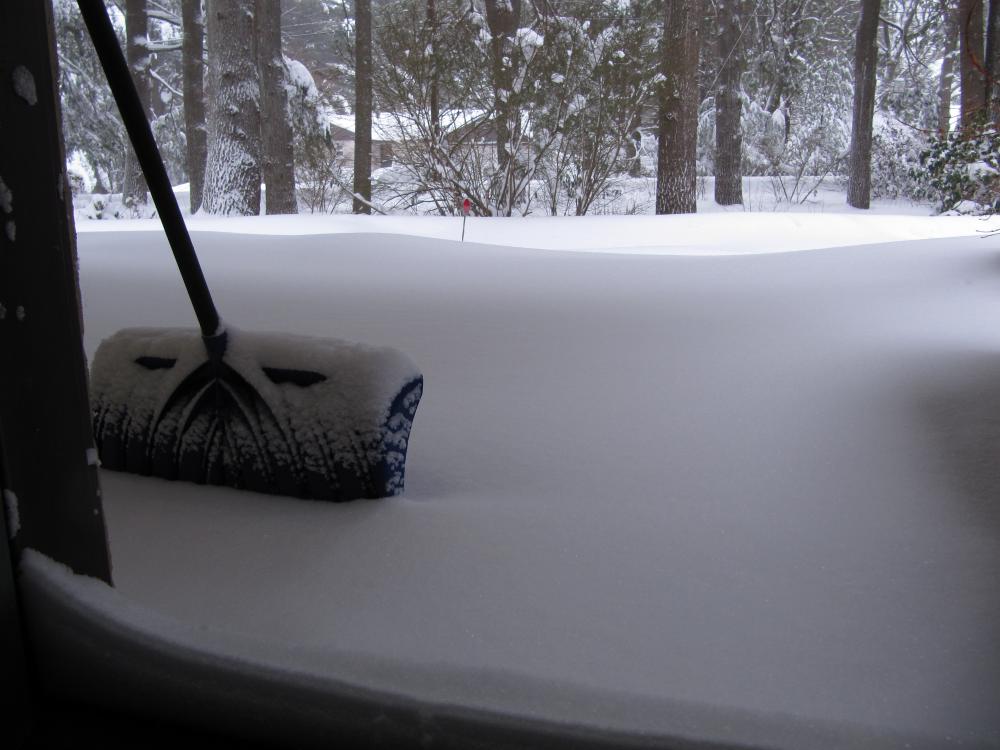 Now, my front door opens onto an entry deck which is about 5.5 m wide (18 feet) and 3.2 m deep (10.5 feet). Because has a roof, it is usually free of snow. But last Saturday, it was completely covered with drifting snow, giving an idea of how powerful were the overnight winds. Once I shoveled the deck a bit and stepped out onto it, here are the views from the deck, first looking left, and then right: 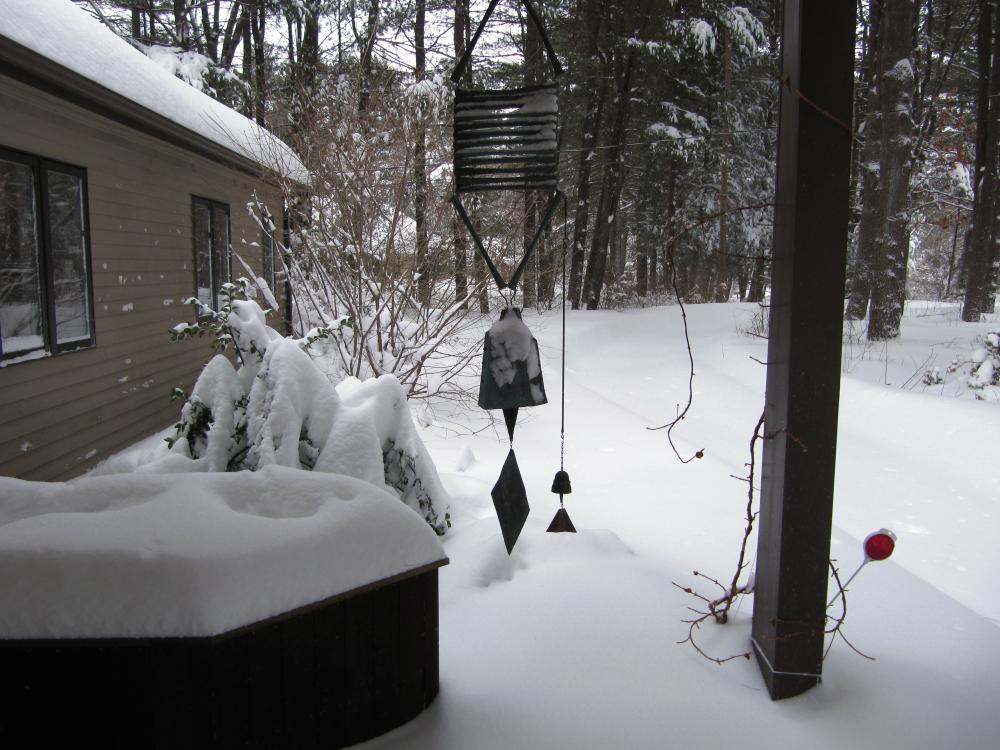 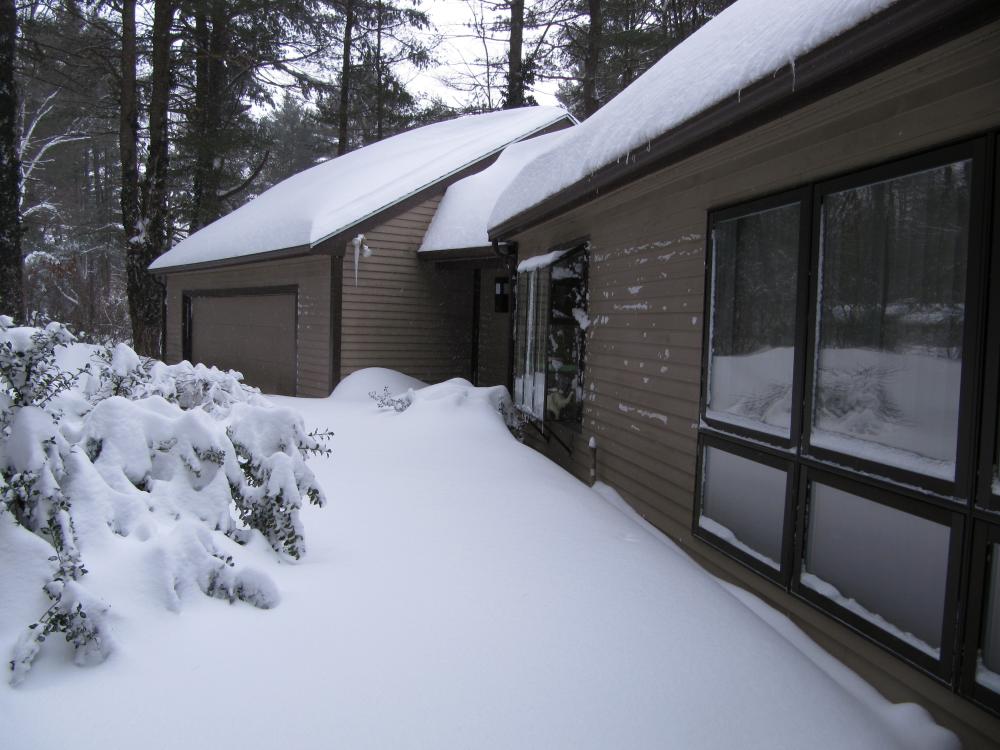 I then went into my garage, and opened the garage door. This is an 18-foot-wide door (5.5 m), which slides up along a track. And here's what I saw: 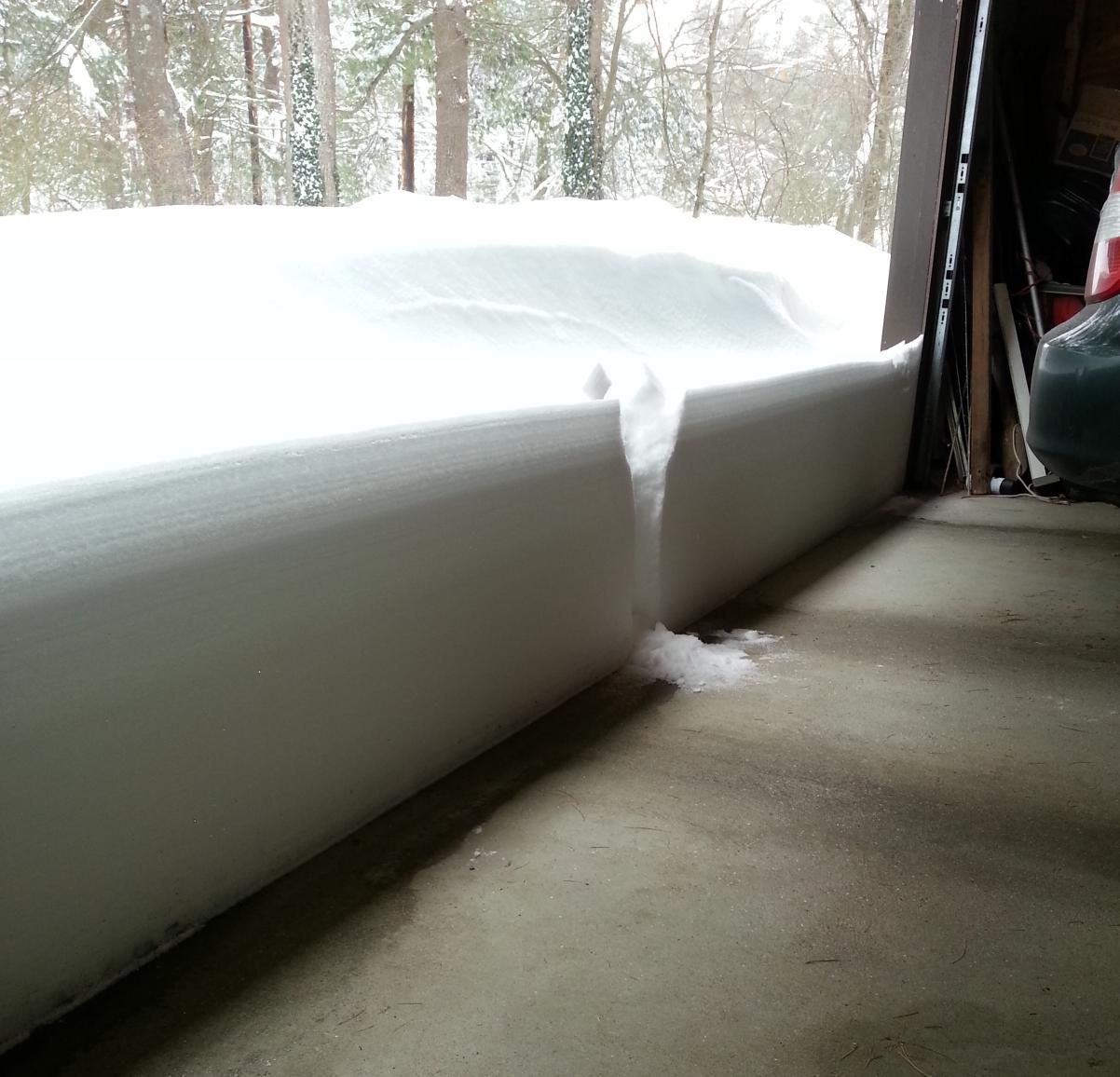
The wall of snow piled up against the garage door was 21 inches tall (52 cm). The snowdrift a few feet beyond the door was 33 inches deep (84 cm). All my measurements were made in inches, because I used an American "yardstick", 36 inches in length. The existence of the yardstick may confirm that lengths of around a meter are convenient for certain types of measurements. I get the feeling that there are some people in this country who think that it would be somehow "un-American" to switch to the metric system. Not those in technical industries, though, who have already made the switch in large numbers. For example, the Ford Motor Company converted to metric measurement in the 1970's. Here are some more photos, if you're interested (again, click to enlarge, and return with your "Back" button). First, snow piled on our barbecue grill (left) and weighting down the branches of some trees near the house (right): 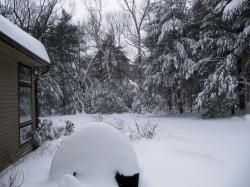
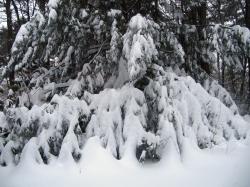 The snow seen through our living room windows (left), and one of Margie's hybrid amaryllis blooms contemplates the cold (right): 
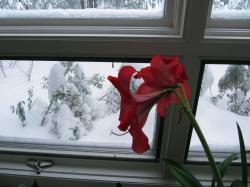 A junco near our feeder tries to keep warm (left). After our driveway was plowed on Saturday, we awoke on Sunday to find that the town plows, widening the street, had raised a wall of snow which I had to remove before we could go out for lunch (right): 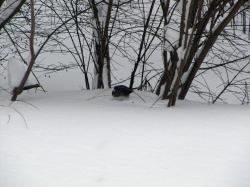
 The Town of Wayland suggested that residents could help the fire department by digging out the Town's fire hydrants. So I walked two doors down, and did just that, as the neighbors were not home (left). The vertical red pole enabled me to find the hydrant under the snow, since it was completely buried. While I was there, since rain was expected, I also cleared a couple of storm drains (right). They were harder to find, but I knew approximately where they were: 
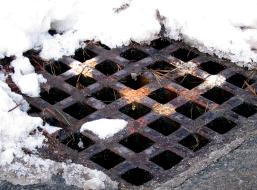 Although we have a new roof, and shouldn't have any problems, I wanted to remove snow in a few places, to prevent "ice dams". These occur when melting water re-freezes along the eaves, and water which backs up behind the dam infiltrates under the shingles.
You can see a video of the system in action on the company's web site. It really does work as well as the video shows. After my neighbors saw me using the Avalanche, and some of them borrowed it, quite a few of them bought their own. The company ought to give me a commission. Click on the photo to see a longer shot, and return with your "Back" button. With this storm, the snow on the roof was actually deeper than the depth of the Avalanche. That didn't stop it from working, as shown in the video, although it does make it a bit harder to push the unit into the snow.
I bought extra pole extensions for my unit, so I can use it from the driveway. As shown on the right, I'm not using them all, because I'm standing close to the house, in a slot I shoveled in the snow to make a path to our heating oil fill pipe, to prepare for our next oil delivery. This is one of the shoveling tasks I need to do by hand: the front deck, a path to our mudroom door, and a path for oil deliveries. Although the Avalanche poles are fiberglass, with all five pole extension segments attached, it gets fairly heavy. A competing product called the Minnsnowta Roof Razor appears to have lighter aluminum poles (they also have a video on their web site). But since these poles have to be pushed, not pulled, I was afraid the poles might be too light, and might bend, so I selected the Avalanche. Never having used the Minnsnowta Roof Razor, I can't compare the units. Just for purposes of comparison, you can see below a photo of a standard "snow rake", which from my point of view has been rendered obsolete by the Avalanche. It has a light aluminum pole, but you pull on it, you don't push: 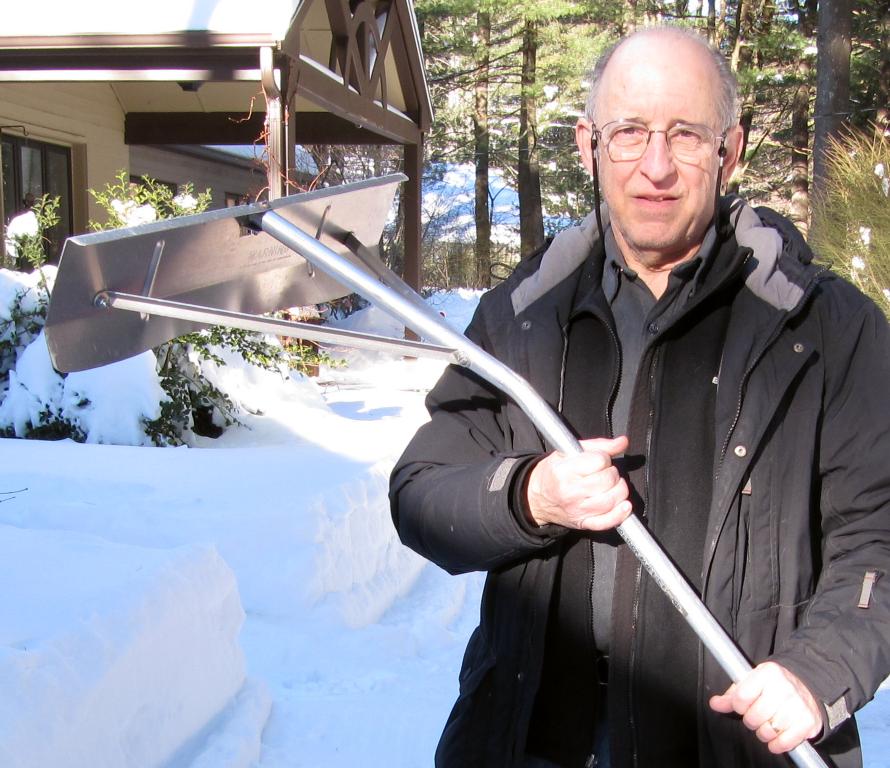 There are two major problems with the standard snow rake. First and foremost, it's a lot of work - you have to drag the snow down over the rough shingles. With the Avalanche, it just slides down under its own weight. Furthermore, the standard rake damages the roof, scraping across the shingles. The Avalanche rolls over the shingles on little wheels. Interestingly, the Globe Handyman Peter Hotton, answering a reader's question, said you should never rake on a pitched roof. He noted that roof rakes damage the roof (the standard ones do, but the Avalanche doesn't), and he feels that clearing snow doesn't prevent ice dams. I don't agree with the latter statement. Before we had our latest roof installed, with "ice and water shield" all the way up, eaves to peak, we had ceiling damage due to water pooling behind ice dams at the eaves. The pools got deep enough to create pressure that forced water up under the shingles. Raking slots into the snow to allow this water to escape definitely alleviated the problem. Now, Hotton is correct in saying that ice dams would not be a problem if our attic were adequately ventilated (it is), and our ceilings were adequately insulated (they're not). Adding the right amount of insulation is by no means an inexpensive project, but as the cost of heat rises, I think we probably ought to go ahead with it. There's not much we can easily do about our two large rooms with cathedral ceilings. The master bedroom roof, in particular, melts snow over the ceiling's top-hat lights, which pierce much of the insulation in the ceiling, and generate heat. In the end, we had it easy here in Wayland. On the coast, the damage was severe in places. In more densely populated cities near us (Boston, Brookline, Cambridge, Somerville, and so on), the streets are still being dug out. It always takes longer to clean up when there is so much snow that it can't be just pushed aside, but rather has to be removed. Here's an article from the Boston Globe on the city's snow removal efforts. And here's a collection of Globe photos of the storm. At the height of the storm, over half a million homes were without electricity. NStar, our power company, provides a web page specifically formatted for smart phones which reports on outages, by town. At 5:00 PM on Sunday, NStar showed 161,396 Massachusetts customers without power. I checked 24 hours later, and there were still 89,528 houses out. At 5:00 PM today, Thursday, the number was down to 192. At this point, many of the remaining outages are probably due to downed lines that affect only a single house. Although we had it easy at our house, it was nevertheless a memorable storm. OK, let's call it "The Blizzard of 2013".
  Note 1: Winter storms are not officially named by the National Oceanic and Atmospheric Administration (NOAA), which names hurricanes. But this storm was named "Nemo" by the Weather Channel, and the name caught on in some places. It's certainly been widely called "The Blizzard of 2013", even though it didn't technically meet the definition of a blizzard. But that name seems to assume that we won't have another one this year. What if, two weeks from now, we get a storm that dumps twice as much snow on us. Won't that one become "The Blizzard of 2013"? It would seem that name ought to only be applied in retrospect. I also thought of naming this blog entry "The blizzard of '13". After all, we usually truncate years to two digits - we speak of "the blizzard of '78", which occurred in 1978. But looking at common usage, it seems that it's too early in the 2000's to start truncating years to two digits. "The blizzard of '13" would sound to us like a storm that occurred in 1913. An odd example of a strange linguistic convention about dates occurs in Italian. They'll refer to "il settecento", meaning literally "the seven hundreds". But this actually refers to the 1700's (the seventeen hundreds, also called the eighteenth century). I don't know what they do when they really want to talk about the 700's (the eighth century). [return to text]
 |

